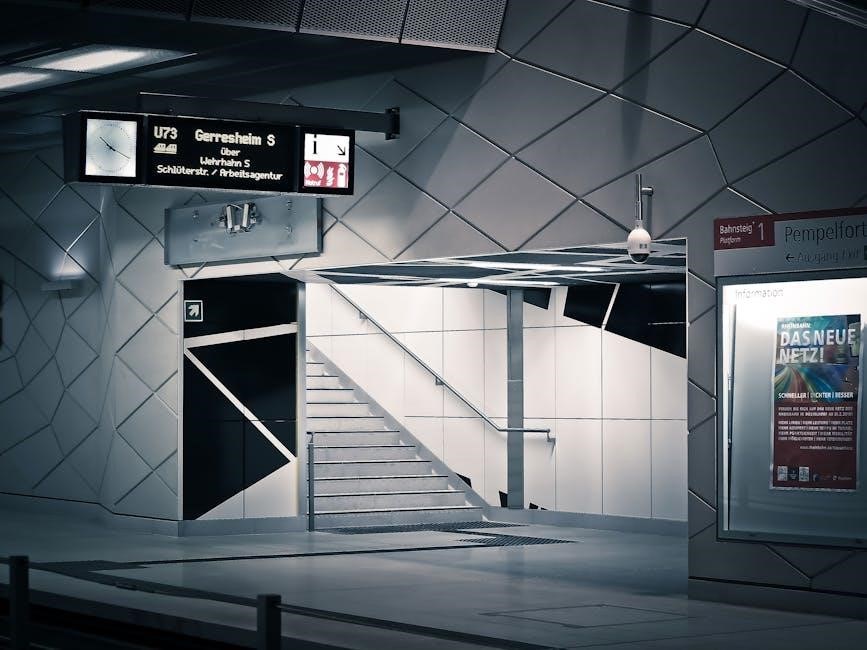Airport terminal design reflects the evolution of aviation, blending functionality, aesthetics, and sustainability to meet growing passenger demands and operational needs effectively while addressing modern challenges like security and capacity.
1.1 Historical Evolution of Airport Terminals
The design of airport terminals has undergone significant transformations since the early 20th century, driven by advancements in aviation technology and growing passenger demand. Early terminals were simple structures focused on basic functionalities like ticketing and baggage handling. The 1920s and 1930s saw the introduction of more formal designs, with terminals reflecting architectural styles of the time, such as Art Deco. Post-WWII, airports expanded rapidly, adopting centralized hub designs to accommodate larger aircraft and increased traffic. The 1960s and 1970s introduced modular concepts, with emphasis on efficiency and passenger flow. Modern terminals now prioritize sustainability, biometric technologies, and seamless user experiences, blending functionality with aesthetic appeal. This evolution highlights how terminal design has adapted to meet the changing needs of aviation and society.
1.2 Importance of Terminal Design in Modern Aviation

Terminal design plays a critical role in modern aviation, impacting operational efficiency, passenger experience, and airport revenue. A well-designed terminal ensures seamless passenger flow, reduces congestion, and enhances safety. It also accommodates advanced technologies like biometrics and smart systems, streamlining processes such as check-in, security, and boarding. Additionally, terminals serve as gateways to regions, reflecting cultural and architectural identities. Sustainable design practices are increasingly prioritized, reducing environmental impact while lowering operational costs. Effective terminal design also supports future expansion, adapting to growing air traffic and evolving industry needs. Ultimately, it balances functionality, aesthetics, and innovation to create a positive travel experience, making it indispensable in the modern aviation landscape.
1.3 Common Challenges in Terminal Design
Terminal design faces numerous challenges, including balancing capacity demands with flexibility for future expansion. Ensuring efficient passenger flow while accommodating diverse operational needs is complex. Environmental concerns, such as reducing carbon footprints, add layers of complexity. Safety and security requirements must be integrated seamlessly without compromising aesthetics. Budget constraints often limit innovative solutions, while regulatory compliance demands strict adherence to international standards. Additionally, terminals must adapt to rapid technological advancements, such as biometrics and smart systems, to maintain efficiency. Cultural and regional influences also play a role in design decisions, requiring a balance between functionality and identity. Finally, coordinating stakeholder interests, from airlines to local authorities, can slow the design process, making it essential to prioritize clear communication and strategic planning to overcome these hurdles effectively.

Planning and Design of Airport Terminals
Effective terminal planning integrates functional zones, master planning, and regulatory compliance to create efficient, scalable, and sustainable facilities, ensuring seamless passenger experiences and adaptability to future demands.
2.1 Site Selection and Feasibility Studies

Site selection for airport terminals involves evaluating land availability, accessibility, and environmental factors to ensure optimal functionality. Feasibility studies assess economic, technical, and operational viability, balancing costs and benefits. Location analysis considers proximity to urban centers, transportation networks, and potential noise impacts. Environmental assessments address ecological concerns, such as habitat preservation and pollution risks. Regulatory compliance ensures adherence to local and international standards. These studies also evaluate future growth potential and infrastructure scalability. By aligning practical, financial, and strategic goals, site selection and feasibility studies lay the foundation for successful terminal design, ensuring long-term sustainability and operational efficiency while minimizing environmental and social impacts.
2.2 Space Allocation and Functional Zones
Effective space allocation in airport terminals ensures seamless passenger flow and operational efficiency. Functional zones are strategically designed to cater to specific activities, such as check-in, security, immigration, and baggage claim. Arrival and departure areas are optimized for clarity and ease of navigation, while security checkpoints are positioned to minimize bottlenecks. Lounges and retail spaces are integrated to enhance passenger comfort and revenue generation. The layout prioritizes accessibility, ensuring compliance with safety and accessibility standards. Advanced technologies, like automated baggage systems, further streamline operations. By balancing functionality with passenger experience, terminal designs create efficient, intuitive environments that support both current and future demands, fostering a harmonious blend of practicality and innovation.
2.3 Master Planning and Future Expansion
Master planning is crucial for aligning airport terminal design with long-term growth and technological advancements. It ensures that terminals are adaptable to evolving passenger needs and operational demands. Modular designs allow for phased expansions, minimizing disruptions while maximizing efficiency. Flexibility in infrastructure enables airports to integrate new technologies and accommodate increasing passenger volumes. Strategic land use and infrastructure planning are key to accommodating future expansions without compromising current operations. By anticipating trends and challenges, master plans provide a roadmap for sustainable development, ensuring terminals remain functional and efficient over time. This forward-thinking approach not only supports scalability but also enhances the overall passenger experience, making it a cornerstone of modern airport design strategies.
2.4 Regulatory Compliance and Standards
Regulatory compliance and adherence to international standards are critical in airport terminal design to ensure safety, security, and efficiency. ICAO and FAA guidelines dictate specific requirements for terminal layouts, security checkpoints, and emergency evacuation systems. Compliance ensures that terminals meet rigorous safety standards, including fire resistance, accessibility, and emergency preparedness. Environmental regulations also play a key role, with green building certifications like LEED influencing sustainable design practices. Additionally, terminals must comply with local building codes and international security protocols to mitigate risks. Regular audits and inspections are conducted to verify adherence to these standards. By integrating regulatory requirements into the design process, airports can ensure seamless operations while maintaining passenger safety and satisfaction. These standards evolve over time, making ongoing compliance a critical aspect of terminal design and management.

Key Design Principles for Airport Terminals
Flexibility, sustainability, and passenger-centric design are core principles, ensuring terminals adapt to growth, minimize environmental impact, and enhance user experience through intuitive layouts and advanced technologies.
3.1 Flexibility and Scalability in Design
Airport terminals must be designed with flexibility and scalability in mind to accommodate future growth and evolving operational needs. Modular designs allow for phased expansions, ensuring that terminals can adapt to increasing passenger traffic and new technologies without disrupting current operations. Incorporating flexible spaces enables airports to repurpose areas as demand changes, such as converting check-in areas to self-service kiosks or adjusting security checkpoints. Scalability also involves planning for future expansions, such as adding new concourses or gates, while maintaining seamless integration with existing infrastructure. This approach ensures that terminals remain efficient and functional over time, even as passenger numbers and airline requirements fluctuate. Flexibility in design is crucial for addressing unforeseen challenges, such as emerging technologies or shifts in travel patterns, making it a cornerstone of modern terminal design strategies.
3.2 Sustainability and Green Building Initiatives
Sustainability is a critical component of modern airport terminal design, with a focus on reducing environmental impact while improving passenger comfort. Green building initiatives, such as energy-efficient systems and renewable energy sources, are increasingly incorporated into terminal designs. Natural lighting, solar panels, and rainwater harvesting systems are common features that minimize resource consumption. Airports also adopt materials with low environmental footprints and implement waste reduction programs. Certification programs like LEED encourage terminals to meet rigorous sustainability standards. These efforts not only reduce operational costs but also enhance brand reputation and passenger satisfaction. By integrating eco-friendly technologies and practices, airports contribute to global sustainability goals while creating healthier, more efficient spaces for travelers.
3.3 Enhancing Passenger Experience
Enhancing passenger experience is a cornerstone of modern airport terminal design, focusing on creating seamless, efficient, and enjoyable journeys. Terminals are designed to minimize stress through intuitive layouts, clear signage, and streamlined processes. The integration of technology, such as self-service check-ins, biometric identification, and real-time information systems, simplifies travel procedures. Comfort is prioritized with amenities like lounges, dining options, and charging stations. Natural light, green spaces, and artistic elements further enhance the ambiance. Accessibility for all passengers, including those with disabilities, is a key consideration. By balancing functionality with hospitality, airports aim to create memorable and positive experiences, fostering loyalty and satisfaction among travelers. These design strategies ensure terminals are not just functional spaces but destinations that reflect the cultural and regional identity of their locations.
3.4 Safety and Security Considerations
Safety and security are paramount in airport terminal design, ensuring the well-being of passengers, staff, and infrastructure. Terminals incorporate advanced surveillance systems, access control, and biometric technologies to prevent unauthorized access and threats. Design elements like blast-resistant materials and reinforced structures enhance resilience against potential attacks. Fire safety systems, including smoke detectors and sprinklers, are integrated to mitigate risks. Emergency evacuation routes and clear signage ensure rapid response in crises. Security checkpoints are strategically placed to balance efficiency with thorough screening. Collaboration between architects, security experts, and stakeholders ensures compliance with international standards. These measures create a secure environment while maintaining a seamless passenger experience. By prioritizing safety and security, terminals safeguard lives and operational continuity, reflecting a commitment to global aviation standards and passenger trust. Effective design balances these critical factors to ensure robust protection without compromising functionality or aesthetics.
3.5 Construction and Engineering Challenges
Airport terminal construction faces numerous engineering challenges, including balancing functionality with aesthetics while adhering to strict safety and regulatory standards. Managing large-scale projects requires precise coordination of architects, engineers, and contractors to ensure timely delivery; Material selection is critical, with a focus on durability, sustainability, and resistance to environmental factors. Integrating advanced technologies, such as biometric systems and IoT, adds complexity to the construction process. Ensuring scalability for future expansion while meeting current demands is a key consideration. Construction logistics, including managing workflows and minimizing disruptions to active airport operations, pose significant hurdles; Compliance with international building codes and environmental regulations further complicates the process. Addressing these challenges demands innovative solutions and collaborative efforts to achieve efficient, safe, and sustainable terminal designs that meet the evolving needs of modern aviation.
Case Studies in Terminal Design
This section explores iconic airport terminals, showcasing designs like Changi’s Terminal 3 and Foster+Partners’ innovations, while highlighting regional and cultural influences in terminal architecture globally.
4.1 Changi Airport Terminal 3: A Benchmark in Design
Changi Airport Terminal 3 is widely regarded as a benchmark in airport design, exemplifying cutting-edge architecture and operational efficiency. Its design emphasizes natural light, lush gardens, and sustainable materials, creating a seamless transition between indoors and outdoors. The terminal features iconic elements like the Butterfly Garden and a kinetic sculpture, enhancing passenger experience. Sustainability is a key focus, with energy-efficient systems and green certifications. The integration of advanced technologies, such as biometric systems and self-service kiosks, streamlines processes. Terminal 3 serves as a model for balancing aesthetics, functionality, and environmental responsibility, influencing future airport design globally.
4.2 Foster+Partners’ Innovative Designs
Foster+Partners has consistently pushed the boundaries of airport terminal design, blending innovative architecture with functional efficiency. Their winning design for the new terminal at Abha International Airport showcases modular construction, reflecting regional architectural character. The design emphasizes adaptability, with a drop-off zone and concourse arranged to maximize functionality while maintaining aesthetic appeal. Foster+Partners’ approach often integrates natural light, open spaces, and sustainable materials, creating welcoming environments for travelers. Their designs also prioritize cultural influences, ensuring terminals resonate with their surroundings. By combining advanced engineering with creative vision, Foster+Partners has set new standards for airport terminals, balancing modernity with practicality and inspiring future aviation infrastructure globally.
4.3 Regional and Cultural Design Influences
Regional and cultural influences play a significant role in shaping airport terminal designs, creating unique identities that reflect local heritage. For instance, the design of Abha International Airport’s new terminal by Foster+Partners incorporates regional architectural character, blending modern functionality with traditional elements. Similarly, Te Hono, the New Plymouth Airport Terminal, designed by Beca, showcases cultural narratives through its architecture, emphasizing local materials and storytelling. These designs not only enhance passenger experience but also foster a sense of place and cultural connection. By integrating regional aesthetics and cultural symbols, terminals become iconic landmarks, reflecting the identity of their locations. This approach ensures terminals are both functional and culturally resonant, offering a seamless blend of modern aviation needs and local traditions while promoting sustainability and passenger satisfaction.
4.4 Lessons Learned from Global Terminals
Global airport terminals offer valuable lessons in design and functionality, highlighting the importance of adaptability, sustainability, and cultural integration. Changi Airport Terminal 3 exemplifies innovation, combining stunning architecture with efficient operations. Similarly, Foster+Partners’ designs emphasize regional character while maintaining modern standards. These examples demonstrate how terminals can balance aesthetics with practicality, prioritizing passenger comfort and security. Key lessons include the need for flexible layouts to accommodate future growth, the integration of green technologies, and the incorporation of cultural elements to create a sense of place. By studying these global benchmarks, designers can develop terminals that are both functional and inspiring, meeting the evolving needs of travelers while reflecting local identity. These insights are crucial for shaping the next generation of airport terminals.

The Future of Airport Terminal Design
The future of airport terminals lies in integrating emerging technologies, biometrics, and sustainable practices to create smarter, more efficient, and passenger-centric facilities while addressing global challenges.
5.1 Emerging Technologies and Biometrics
Emerging technologies and biometrics are revolutionizing airport terminal design by enhancing security, efficiency, and passenger experience. Facial recognition and biometric scanning are being integrated to streamline check-in, baggage handling, and security checks, reducing wait times and improving accuracy. These technologies also enable personalized services, such as tailored notifications and seamless navigation through terminals. Smart airports leverage IoT devices to monitor and manage resources, optimizing energy consumption and operational performance. Artificial intelligence is being used to predict passenger flow and manage capacity dynamically. Biometric identity verification ensures secure and contactless interactions, aligning with modern safety standards. These advancements are reshaping terminal design to create intelligent, adaptive, and passenger-centric environments, setting new benchmarks for the aviation industry. The integration of these technologies ensures airports remain efficient, secure, and sustainable for future generations.

5.2 Modular and Adaptive Construction Methods
Modular and adaptive construction methods are transforming airport terminal design by offering flexibility and scalability. Modular construction involves prefabricating components off-site, reducing on-site assembly time and minimizing disruptions. This approach allows for easier integration of new technologies and future expansions. Adaptive design enables terminals to adjust to changing passenger needs, such as reconfigurable seating areas or movable security checkpoints. These methods also promote sustainability by reducing waste and optimizing resource use. Modular designs often incorporate green building materials, aligning with environmental goals. By adopting these techniques, airports can efficiently adapt to growth, technological advancements, and evolving passenger demands, ensuring long-term functionality and efficiency. This approach not only enhances operational adaptability but also aligns with modern architectural trends, creating terminals that are both functional and aesthetically pleasing for decades to come.
5.3 Smart Airports and IoT Integration
Smart airports are revolutionizing terminal design by integrating Internet of Things (IoT) technologies to enhance efficiency and passenger experience. IoT enables real-time data collection and analysis, optimizing operations like baggage handling, security screening, and traffic flow. Sensors and connected systems monitor terminal conditions, ensuring energy efficiency and proactive maintenance. Smart airports also leverage technologies like facial recognition, biometrics, and mobile apps to streamline check-in, boarding, and wayfinding. IoT-driven insights improve resource allocation, reducing wait times and enhancing safety. By connecting infrastructure, services, and passengers, smart airports create a seamless, intuitive, and personalized travel experience. This integration of advanced technologies is reshaping terminal design, making airports more intelligent, responsive, and sustainable for future generations. The adoption of IoT is thus critical for modernizing airport operations and meeting growing passenger demands effectively.
5.4 Future Trends and Innovations

Future trends in airport terminal design emphasize sustainability, technology integration, and passenger-centric innovations. Biometric systems, autonomous vehicles, and AI-driven analytics will enhance security and operational efficiency. Modular, adaptive designs will enable terminals to scale dynamically, addressing fluctuating demand and future uncertainties. Green technologies, such as solar energy and carbon-neutral materials, will dominate construction to meet environmental goals. Additionally, terminals may incorporate immersive technologies like AR/VR for wayfinding and entertainment, creating a seamless, personalized travel experience. Cultural and regional influences will also shape designs, blending modern functionality with local architectural identities. These advancements aim to create smarter, more resilient, and inspiring airport terminals that prioritize both functionality and passenger well-being, setting new benchmarks for the aviation industry. The fusion of innovation and sustainability will redefine terminal design for decades to come.
